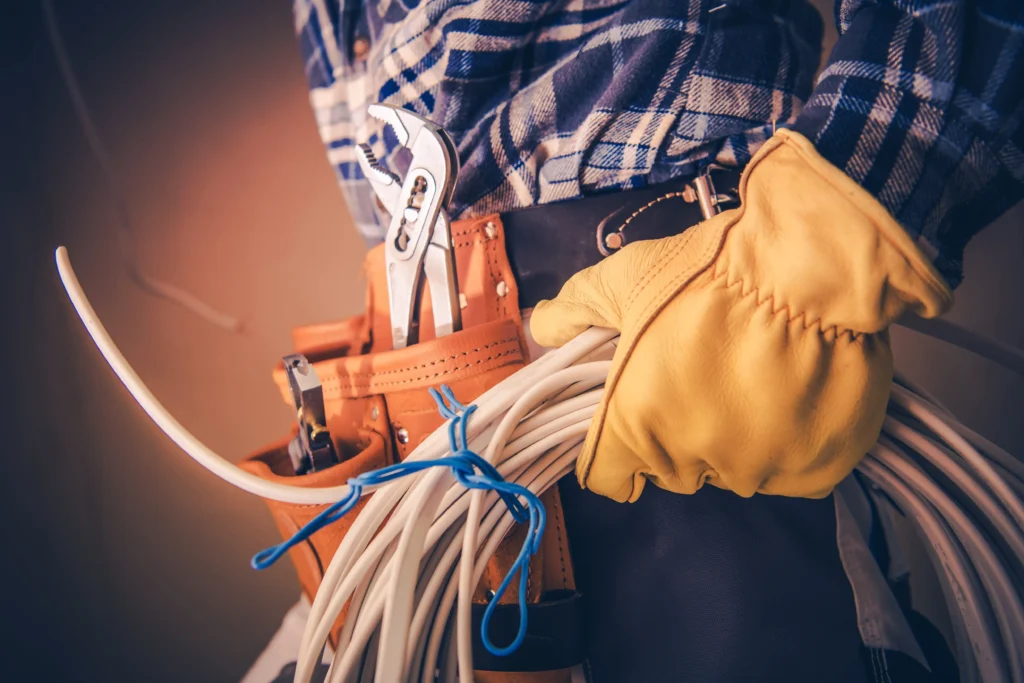
Fiber Optic Construction
Fiber optic construction is the process of deploying and installing fiber optic networks to provide high-speed internet connectivity, voice, video, and data services to homes and businesses. It involves the installation of fiber optic cables, which transmit data using light signals. Fiber optic construction is a cost-effective means of enabling network access in areas with substantial telecommunications traffic.

How Fiber Optic Networks Are Constructed
Fiber optic networks can be constructed using two primary methods: underground and aerial fiber deployment.
Underground Fiber Deployment:
In underground construction, fiber optic cables are placed within a conduit system, which is buried beneath the ground. Several techniques are employed for this purpose:
Plowing: Fiber cables are buried using a plow that creates a narrow trench and simultaneously lays the cable.
Trenching: A trench is dug in the ground, and the fiber cables are placed within it.
Jack and Bore: This method involves drilling a hole under obstacles like roads or buildings and then pulling the fiber cable through the bored hole.
Multi-Directional Bore: Similar to jack and bore, this method allows for drilling in various directions to navigate around obstacles.
Directional Bore: This technique is used for horizontal drilling and is employed when it is necessary to install fiber cables underground without extensive trenching.

Aerial Fiber Deployment:
In aerial construction, fiber optic cables are mounted on utility or telephone poles above ground. This method is often used when burying cables is not feasible or cost-effective.
Strand Count in Fiber Optic Cables
Fiber optic cables consist of multiple glass fiber strands, and the number of strands, known as the “strand count,” can vary. Older networks typically used cables with 36, 48, 72, 144, and 288 fiber strands in each cable. However, newer fiber optic cables are being designed with much higher strand counts, such as 432, 864, and even 1,728 fiber strands in a single cable.
Higher strand count fiber optic cables are primarily deployed on core network routes, connecting a telecommunications provider’s central office (CO) to various points in the network. These cables provide ample capacity for current and future data transmission needs, ensuring that te network can handle increasing traffic demands.
In summary, fiber optic construction involves deploying fiber optic cables either underground or overhead, and the strand count in these cables varies depending on the specific requirements of the network. Higher strand count cables are particularly used in core network routes to accommodate future growth in telecommunications traffic.
Fiber Route Miles and Fiber Strand Miles
Fiber Route Miles: Fiber route miles refer to the total length of a fiber optic network, measured in non-overlapping miles. It represents the physical extent of the fiber optic cables that make up the network. For example, if a fiber optic network spans 10 miles from point A to point B, it would be referred to as having 10 fiber route miles.
Fiber Strand Miles: Fiber strand miles represent a different metric. It is the number of route miles in a network multiplied by the number of individual fiber strands within each fiber optic cable on that network. For instance, if a 10-mile fiber route contains a cable with 288 fiber strands, it would be described as having 2,880 fiber strand miles. This metric takes into account both the length of the network and the capacity provided by the number of strands in the cables.
Duration of Fiber Construction
The duration of fiber construction can vary significantly based on several factors, including the scale and complexity of the project. However, as a general guideline:
Fiber construction typically takes between 6 to 10 months for a network to become operational once the construction or build-out phase commences. This timeline may include the installation of the necessary infrastructure, such as fiber optic cables, conduits, and related equipment.
It’s important to note that the construction timeline can be influenced by:
The total number of route miles to be constructed: Longer networks will naturally require more time to build.
The number of homes or premises targeted for connection to the network: Extending the network to reach more locations can increase the construction time.
The deployment method: Underground and aerial construction may have different timelines.
Overall network complexity and scale: More extensive and intricate networks may require longer construction periods.
In summary, the duration of fiber construction can vary based on the specific project’s characteristics, but a typical range for network readiness is 6 to 10 months after construction begins.

Fiber Cable Burying Process
Fiber optic construction involves both underground and aerial deployment of fiber optic cables. Here’s how fiber cables are buried underground:
Conduit Construction for Fiber Optic Cables:
Conduit: Conduit, often referred to as a tube, is used to house and protect the fiber optic cables. There are various types of conduits used, including HDPE (polyethylene plastic), PVC (vinyl polymer plastic), and steel.
Innerduct: In many cases, an innerduct, which is a separate tube within the conduit, is used. The innerduct divides the larger conduit into subsections, ensuring that the fiber optic cable doesn’t run directly inside the split/solid conduit. This helps organize and protect the cables.
Methods of Installation:
Plowing, Trenching: The conduit is buried in the ground using plowing or trenching equipment.
Jack and Bore, Multi-directional Bore, Directional Bore: In more challenging situations or where minimal disruption is required, techniques like jack and bore, multi-directional bore, or directional bore may be used. These techniques help create underground pathways for the conduit without extensive digging.
Fiber Optic Cable Installation:
Once the conduit is in place, the fiber optic cable is installed or “pulled” through the conduit. Larger installations may involve either pulling or blowing the cable.
Pulling: A powered pulling winch, along with hydraulic powered assist pulling wheels, is used to apply a maximum pulling force to the fiber optic cable.
Blowing: A sealed pneumatic cable blowing system, which uses compressed air, “jets” multiple innerducts into the conduit.
Slack cable: A certain amount of slack cable (usually 65 to 150+ feet) is often left in intermediate handholes, manholes, splice locations, and facility locations to allow for future maintenance and connections.
Depth of Fiber Optic Cable Burying:
Fiber optic cable is usually buried in conduits at a depth of 3 feet to 4 feet (equivalent to 36 inches to 48 inches) underground. Specific installation agreements may stipulate a minimum depth of 42 inches.
In certain environments, such as near roads, highways, or railroads, depths of 48 inches may be required. In areas where conduits cross waterways, a depth of 60 inches is often the minimum requirement.
Microtrenching for Fiber:
Microtrenching is an alternative method to bury fiber optic cable, and it is known for reducing the time to build a network while causing less disruption. This method involves burying fiber optic cable at shallower depths of only 8 to 16 inches and creating a narrow trench that is only 1 to 2 inches wide.
While microtrenching speeds up network deployment and minimizes disruption (e.g., road closures), it may not necessarily reduce the overall cost of constructing a fiber optic network.
Microtrenching is particularly suitable for areas where traditional trenching or plowing may be less practical due to infrastructure or environmental constraints.
Aerial Fiber Construction Process
Aerial fiber optic cable is installed above ground, typically on existing utility and telephone poles. Here’s how aerial fiber is installed:
New Pole Attachment: Aerial fiber can be installed by attaching cables to new utility or telephone poles. This method may be employed when additional poles are needed to support the fiber network.
Overlashing: Overlashing involves attaching the new cable to an existing cable that is already suspended on utility poles. To achieve this, the new cable is placed alongside the existing cable, and both cables are bound together by spinning wire that wraps around them. This technique allows for the expansion of the aerial fiber optic network without requiring additional space on the pole.
Securing Rights for Aerial Fiber Installation:
Providers of aerial fiber typically secure the necessary rights for pole attachments and overlashing from utility companies that own the poles. This allows them to utilize the space on these utility poles for the installation of fiber optic cables.
Fiber Construction Costs:
The cost of laying fiber optic cables can vary significantly based on multiple factors. Here are some key details regarding fiber construction costs:
How Much Does it Cost to Lay Fiber?
On average, it costs between $1,000 to $1,250 per residential household passed or $60,000 to $80,000 per route mile to bury or “lay” fiber optic cable. “Households passed” refers to the fiber optic cable built along residential streets, excluding the final connection or “drop” into individual homes, which is handled through lateral fiber connections.
Drivers of Fiber Construction Costs:
Several factors can significantly impact the costs of fiber construction:
Labor: Physical labor is the most significant cost component in fiber construction, often comprising over 60% of total costs.
Population Density: The population density of an area affects construction costs. Fiber construction costs tend to be lower in densely populated urban areas and higher in sparsely populated rural areas.
Depth or Height: Whether the fiber is installed underground (in conduit systems) or above ground on utility poles affects costs. Underground installations are typically more expensive.
Terrain: Fiber must be constructed across various types of land, some of which can be more costly to traverse. For instance, building fiber around or through mountains, hills, valleys, and natural obstacles like rivers, rocks, and varying soil types can impact costs.
Equipment: Costs for fiber optic transmission and electronic equipment can vary depending on the length and complexity of the network.
Existing Conduit: Carriers that have existing conduit infrastructure, such as copper conduits, can benefit from lower costs when pulling fiber optic cable through them.
Incorporating Existing Infrastructure:
Utilizing existing conduit infrastructure for fiber construction, where available, can significantly reduce the overall cost. For example, carriers with access to existing conduit capacity may realize cost savings.
Fiber Construction Costs:
The cost of laying fiber optic cables can vary significantly, depending on various factors. On average, it costs between $1,000 to $1,250 per residential household passed or $60,000 to $80,000 per route mile to bury fiber optic cable.
Drivers of Fiber Construction Costs:
Several factors influence construction costs, including labor, population density, depth or height of the fiber deployment, terrain, equipment, the presence of existing conduit, make-ready costs, and permitting costs.
Examples of Fiber Construction Costs:
Fiber Broadband Association and Cartesian Study:
Urban areas: Costs range from $700 to $1,500 per household passed.
Rural areas: Costs range from $3,000 to $6,000 per household passed.
Shentel (Shenandoah Telecommunications):
Shentel’s Glo Fiber brand aims to pass 450,000 homes by 2026.
Estimated build capital expenditures (CapEx) average $1,200 per passing, with a range of $1,000 to $1,400 per passing.
Aerial Fiber Installation Costs:
Aerial fiber installation, known as overlashing, costs an average of $8 to $12 per foot or about $40,000 to $60,000 per mile. Costs vary by geographical area, with urban areas being the most expensive and rural areas being more cost-effective due to fewer obstructions.
Frontier Communications benefits from an approximate $30 savings per location passed through overlashing its aerial copper lines.
These insights provide a comprehensive overview of the cost factors involved in fiber construction, making it clearer how different elements can impact the overall expenses of deploying fiber optic networks.
Aerial Fiber Construction:
Aerial fiber deployments typically require only days or weeks to connect, making them significantly faster than underground fiber construction, which can take several months.
Aerial Fiber Construction Costs:
Aerial fiber construction costs encompass various expenses, including pole attachment costs, fiber materials, installation, and splicing.
“Make ready costs” are a significant component of aerial fiber network construction expenditures. These costs involve engineering and rearrangement of existing cables on utility or telephone poles to prepare them for the attachment of new fiber optic cable.
These insights underscore the efficiency and quicker deployment times associated with aerial fiber construction, making it a practical choice in certain environments, while also highlighting the importance of considering all cost components when planning such deployments.
